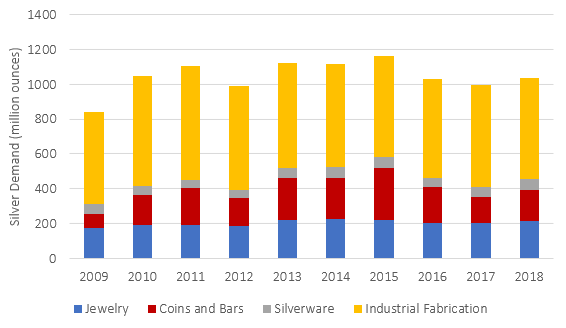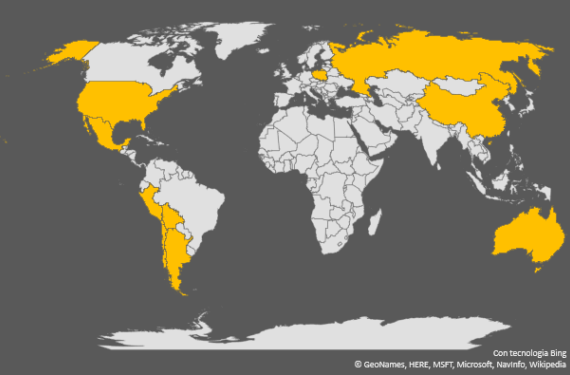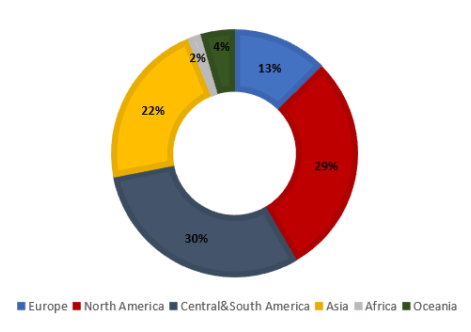Silver has many qualities, that make it an extremely useful material.
What Is Silver?
Silver, the white metal, is a rare and precious material. Silver is a noble metal because it can resist corrosion and oxidation, although not like gold. It is the largest thermal and electrical conductor among all metals. It has antimicrobial and non-toxic properties. It has a high gloss and reflectivity and is malleable, ductile and photosensitive. Silver can be made into paste or powder, bound with other metals, flattened into printable sheets. All these qualities make it an extremely useful and prestigious material.
Current and Future Use
Uses of silver vary a lot (Figure 1). Used for jewellery and coins making, it also plays a very important role in the production of solar cells. Today the main use of silver is industrial. It is found in every electronic device. Its conductivity makes it the choice for everything from printed circuit boards to switches to TV screens. Silver is also a common catalyst for many production processes. The addition of silver to the welding process helps produce smooth, watertight, electrically conductive and corrosion resistant joints. This material is also used in motor bearings and more recently, silver coatings have been placed on medical devices to help fight infections. It is also applied to artificial bones and in recent years scientists have discovered its effectiveness against bacteria. Furthermore, artificial nerve cells that use silver advance artificial intelligence. Every electrical connection in a modern car is activated with silver-plated contacts. Although in small
quantities this material is present in the batteries of hybrid and electric vehicles. Silver is contained in water purifiers. Today, despite the popularity of digital photography that has almost completely replaced it, silver cinematography has become a sort of commodity and the market for ancient and contemporary works is growing.
Production
Silver is found in the earth's crust alone in a pure form known as "native silver". Most commonly, it is extracted as a secondary metal mainly found combined with gold, copper and lead, from which it must be separated. The first silver producing country is Mexico, whose production in 2018 increased, reaching a record level of 196.6 million ounces. Peru, the world's second largest producer, instead recorded a 2% drop in production to 144.9 million ounces. The third country for silver production is China, where there was a 2% increase in production compared to 2017. Production rebounded from the effects of the most severe environmental controls, which occurred in 2017. After meeting the new requirements of the government, the mines recorded a modest recovery. Russia ranks fourth, followed by Chile. Bolivia, Poland, Australia, United States and Argentina are among the largest producing countries (Figure 2).
Silver Price Evolution
Unlike the relatively slow first half of 2019, the second half recorded important movements in the price of silver, rising to the highest levels ever seen since 2016. White metal is influenced by many of the same issues concerning gold. The Fed's interest rate cuts had a great impact on the price. Initially, precious metals responded negatively to the cut, with silver and gold falling slightly after the announcement; however, both have regained lost ground. Silver, compared to gold, is more abundant, and therefore much less expensive. In addition, it tends to move late. This happens because a large part of it is produced as a by-product from the mines of gold, lead, zinc and copper. The mines do not change their production, which results in a delayed response on the supply side.
To Conclude...
Silver has an illustrious reputation. To date, are constantly emerging new ideas and innovations that can exploit the unique properties of this metal. As in the case of gold, silver production is well diversified, as it occurs in all regions of the world in a relatively balanced way (Figure 3). This ensures that the future of the material is not excessively linked to the individual. Moreover, as described above, the fields of application of silver are numerous. There is therefore also diversification from the point of view of demand. This further reduces the risk associated with it. In 2018 silver production costs decreased. The decline occurred for the sixth consecutive year. This global trend is fuelled by increased production and by-product credits. To conclude, as for gold, the drop in production costs, together with the good diversification (both linked to production and fields of use) that characterizes silver, represent a positive signal for the future utility of the metal.


